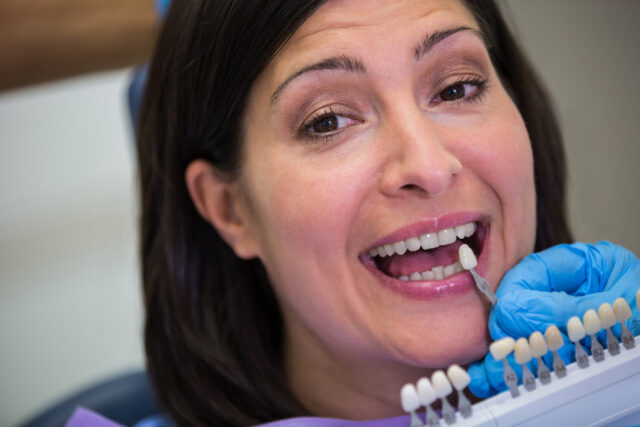
The dental implant process in Long Beach represents a significant investment in oral health and aesthetic improvement. Patients considering this procedure should understand the thorough/detailed/in-depth nature of the treatment, which typically spans several months from initial consultation to final restoration. While the journey involves multiple steps and careful planning, the end result offers a permanent solution to missing teeth. The following information outlines each phase of the implant process and what patients can expect.
Initial Consultation and Dental Examination
Before beginning any dental implant procedure, patients must undergo a thorough consultation and examination with a qualified implant dentist in Long Beach. During this initial visit, the dentist evaluates the patient’s oral health, medical history, and specific dental needs.
The preliminary exam includes an extensive assessment of the patient’s jaw structure, bone density, and surrounding teeth. Advanced diagnostic imaging, including 3D scans and digital X-rays, helps determine if there is sufficient bone mass to support the implant. The dentist also examines gum health and identifies any existing dental conditions that require treatment before implant placement. Based on these findings, the dental professional develops a customized treatment plan, discusses available implant options, and provides a detailed timeline for the procedure.
Treatment Planning and Cost Considerations
The dental implant process begins with a thorough assessment where Long Beach dental professionals evaluate a patient’s oral health and determine candidacy for implants. Treatment planning includes reviewing financing options, such as payment plans, dental insurance coverage, and third-party financing programs to help manage the investment. The detailed cost analysis typically covers surgical procedures, materials, anesthesia, and any preliminary work like bone grafting or extractions that may be necessary.
Initial Consultation and Assessment
During initial consultations for dental implants in Long Beach, patients undergo thorough oral examinations and diagnostic imaging to determine their candidacy for the procedure. A detailed dental evaluation assesses bone density, gum health, and existing dental conditions, while advanced imaging techniques provide detailed views of oral structures and potential implant sites.
The dentist conducts a thorough medical history review to identify any underlying health conditions or medications that could affect the implant process. This evaluation includes checking for periodontal disease, examining remaining teeth, and measuring jawbone volume. The assessment also determines whether additional procedures, such as bone grafting or sinus lifts, may be necessary before implant placement. Based on these findings, the dental team develops a personalized treatment strategy tailored to each patient’s specific needs.
Financing and Insurance Options
Understanding financial aspects of dental implant treatment allows patients to make informed decisions about their care. Long Beach dental practices typically offer multiple payment options to help make implant procedures more accessible. Many providers accept major insurance plans, though coverage for implants varies extensively between policies.
Patients can explore various financing assistance programs, including healthcare-specific credit cards and third-party financing companies that offer competitive interest rates. Most dental offices provide flexible payment plans, allowing costs to be distributed over several months. Some practices also participate in dental savings programs or offer in-house membership plans that provide discounted rates on implant procedures.
Before proceeding with treatment, patients should consult with their insurance provider and dental office’s financial coordinator to understand their coverage and explore available payment solutions.
Detailed Treatment Cost Breakdown
Thorough dental implant treatment in Long Beach typically ranges from $3,000 to $6,000 per single tooth implant, with costs varying based on specific patient needs and procedural complexity. The total expense encompasses several components: initial consultation ($100-200), diagnostic imaging ($300-500), implant placement surgery ($1,500-3,000), abutment ($500-700), and final crown restoration ($1,000-2,000).
Additional procedures such as bone grafting or sinus lifts may increase costs by $1,000-3,000. Patients engaging in financial planning should consider comparing costs between providers while maintaining focus on quality and expertise. Cost comparison research reveals that Long Beach prices align with regional averages, though fees at specialized surgical centers may trend higher than general dental practices.
Pre-Implant Dental Work and Preparation
Successful dental implant procedures require thorough preparation and preliminary dental work to guarantee desirable outcomes. Dentists must first evaluate and address any pre-existing dental conditions, including gum disease, bone loss, or infections that could compromise implant success. This assessment typically involves comprehensive X-rays, CT scans, and oral examinations.
Tooth extraction considerations play a vital role in the preparation phase. If damaged teeth remain in the implant site, they must be carefully removed, followed by adequate healing time. Some patients may require bone grafting or sinus lifts to ascertain sufficient jawbone density for implant placement. Additionally, dentists evaluate the patient’s overall health status, including conditions like diabetes or smoking habits, which can affect healing and implant integration.
The Surgical Procedure: Implant Placement
Once pre-implant preparations are complete and healing has occurred, the dental implant surgery begins with local anesthesia administration to certify patient comfort.
The oral surgeon makes a precise incision in the gum tissue to expose the jawbone at the implant site. Using specialized surgical instruments, they create a carefully sized hole in the bone where the titanium implant post will be placed. Anesthesia considerations may include additional sedation options for anxious patients or complex cases.
The implant is then surgically inserted into the jawbone and secured firmly in place. While complications are rare, potential risks include infection, nerve damage, or implant rejection. The surgical site is then closed with sutures, and patients receive detailed post-operative care instructions to validate proper healing during the osseointegration period.
Recovery and Osseointegration Period
During the recovery period following dental implant surgery, patients typically experience mild to moderate discomfort that can be managed with prescribed pain medications and cold compresses. Most patients can return to work within 2-3 days, though complete healing requires several months.
The osseointegration process, where the implant fuses with the surrounding bone, takes 3-6 months. During this time, bone growth occurs around the implant, creating a stable foundation for the future crown. Patients must maintain meticulous oral hygiene and attend follow-up appointments so their dentist can monitor healing progress. Smoking, excessive alcohol consumption, and strenuous physical activity should be avoided during the initial healing phase, as these factors can impair proper bone integration and potentially lead to implant failure.
Abutment Placement and Gum Healing
The abutment placement marks a critical phase in the dental implant process, where a connector piece is surgically attached to the integrated implant post. During this minor procedure, the dentist reopens the gum tissue to expose the implant, attaches the abutment, and then closes the tissue around it while leaving the top portion exposed. Patients typically experience 1-2 weeks of gum healing following abutment placement before the final crown can be attached.
Abutment Attachment Procedure
After the dental implant has fully integrated with the jawbone, patients undergo the essential abutment attachment phase of treatment. During this procedure, the dentist carefully selects appropriate implant abutment materials, typically titanium or zirconia, based on specific patient needs and aesthetic requirements.
The dentist makes precise measurements to determine proper abutment size considerations, accounting for factors such as gum thickness, bite alignment, and crown specifications. Using specialized dental tools, they expose the implant and attach the selected abutment through either cement retention or screw retention methods. The abutment serves as the critical connector between the implant and the final restoration. Following attachment, the surrounding gum tissue is sutured around the abutment, and patients receive detailed care instructions to guarantee optimal healing before the final crown placement.
Recovery Time After Placement
Following abutment placement, patients typically experience a gum healing period lasting 10-14 days. During this time, the soft tissue around the implant site gradually adapts to the newly attached abutment, forming a protective seal.
Pain management during recovery usually involves over-the-counter medications, though dentists may prescribe stronger options if needed. Patients should follow activity restrictions for the first 48-72 hours, avoiding strenuous exercise and maintaining a soft food diet to prevent disruption of the healing site.
Most individuals can return to normal daily activities within a few days, though complete healing of the gum tissue may take up to two weeks. Regular monitoring of the site and maintaining proper oral hygiene, while being gentle around the abutment area, helps facilitate optimal healing outcomes.
Custom Crown Design and Fitting
Once dental implant integration is complete, patients enter the pivotal phase of custom crown design and fitting. During this stage, the dentist takes detailed digital impressions and measurements to guarantee optimal crown placement and appearance. These specifications guide the fabrication of a permanent crown that seamlessly matches the patient’s natural teeth.
The process involves selecting from various customizable crown features, including material type, shade, and translucency. Advanced dental laboratories utilize CAD/CAM technology to create personalized crown aesthetics that consider factors such as adjacent tooth color, bite alignment, and facial symmetry. Once fabricated, the crown undergoes careful fitting and adjustment to confirm proper function and comfort. The dentist evaluates the crown’s appearance, bite relationship, and contact with surrounding teeth before permanent attachment to the implant.
Aftercare and Long-Term Maintenance
The long-term success of dental implants depends heavily on proper aftercare and consistent maintenance routines. Patients must follow specific hygiene requirements, including gentle brushing with a soft-bristled toothbrush and daily flossing around the implant site. Regular professional cleanings every six months are essential to prevent bacterial buildup and potential complications.
Diet considerations play a vital role during the healing phase and beyond. Patients should avoid hard, crunchy foods that could damage the implant or crown, particularly in the weeks following surgery. Maintaining a balanced diet rich in calcium and vitamin D supports bone health and implant stability. Additionally, smoking cessation and limiting alcohol consumption greatly improve implant longevity. Regular check-ups with the dentist allow for early detection of any potential issues and guarantee the implant’s continued functionality.
Benefits of Choosing Long Beach Dental Implants
Selecting dental implants in Long Beach offers patients distinct advantages due to the city’s concentration of experienced implant specialists and state-of-the-art dental facilities. The region’s dental professionals maintain high standards of care while utilizing advanced technology and modern techniques to guarantee optimal outcomes.
Long Beach dental practices excel in achieving both aesthetic appeal and functional restoration through customized treatment plans. Patients benefit from comprehensive care that includes detailed consultations, precise surgical planning, and ongoing support throughout the recovery process. The city’s dental implant specialists often collaborate with local laboratories to create perfectly matched prosthetics that blend seamlessly with natural teeth. Additionally, Long Beach’s competitive dental market helps maintain reasonable pricing while making sure quality care remains accessible to residents seeking permanent tooth replacement solutions.
Frequently Asked Questions
Can I Eat Normally While Wearing Temporary Crowns During the Implant Process?
Patients who wear temporary crowns should modify diet temporarily, avoiding sticky, hard, or chewy foods. Soft foods are recommended to protect the temporary restoration and guarantee successful healing during the implant process.
Will My Dental Insurance Cover Implant Procedures in Long Beach?
Insurance coverage eligibility for dental implants varies by provider and plan. Patients should verify benefits with their insurance company and discuss available implant payment plans with their dental office for uncovered expenses.
How Long Do Dental Implants Typically Last Before Needing Replacement?
Dental implants can last 25 years to a lifetime with proper care. Implant longevity estimates vary based on oral hygiene, lifestyle factors, and placement quality. Implant failure risk factors include smoking, grinding, and poor maintenance.
Can I Get Dental Implants if I’m Diabetic or Have Other Health Conditions?
Patients with diabetes and other medical conditions may qualify for dental implants, subject to dental implant eligibility requirements. Conditions affecting bone density and blood sugar control are key factors physicians evaluate before proceeding with treatment.
Is It Possible to Get Multiple Dental Implants Placed in One Appointment?
Multiple dental implants can be placed during single stage implant placement procedures. Many patients successfully receive multi unit implant procedures in one appointment, though treatment complexity and individual health factors determine feasibility.
Disclaimer
The information contained in South Florida Reporter is for general information purposes only.
The South Florida Reporter assumes no responsibility for errors or omissions in the contents of the Service.
In no event shall the South Florida Reporter be liable for any special, direct, indirect, consequential, or incidental damages or any damages whatsoever, whether in an action of contract, negligence or other tort, arising out of or in connection with the use of the Service or the contents of the Service. The Company reserves the right to make additions, deletions, or modifications to the contents of the Service at any time without prior notice.
The Company does not warrant that the Service is free of viruses or other harmful components












